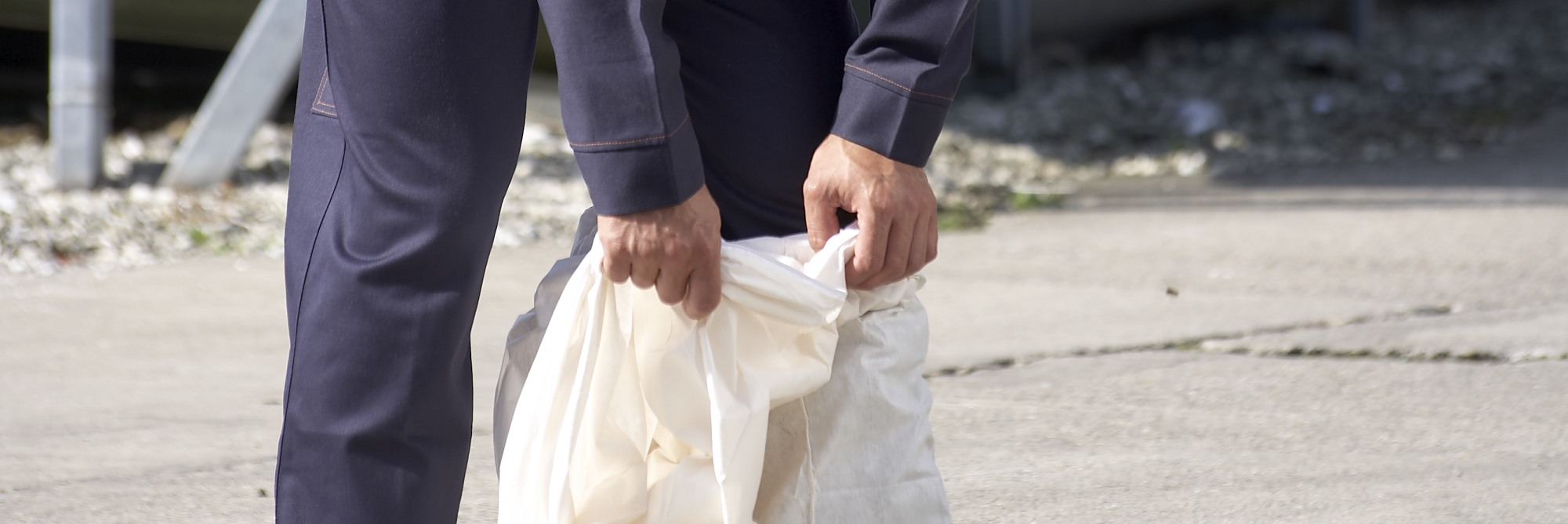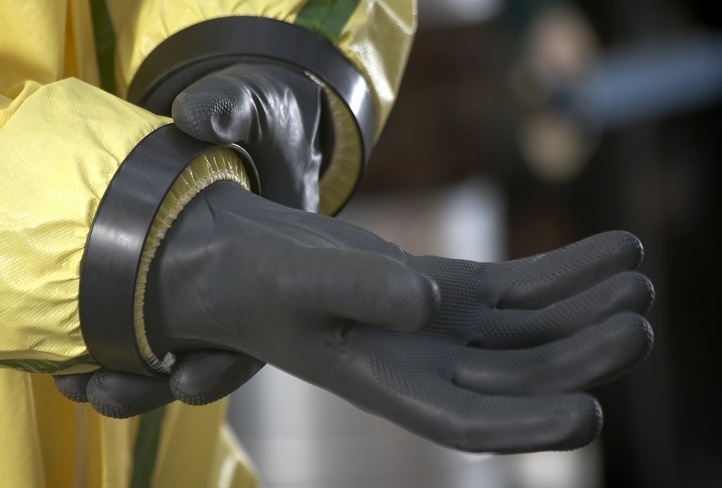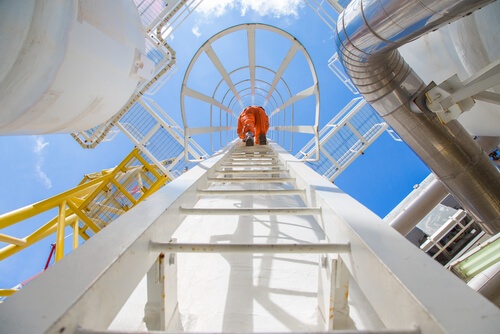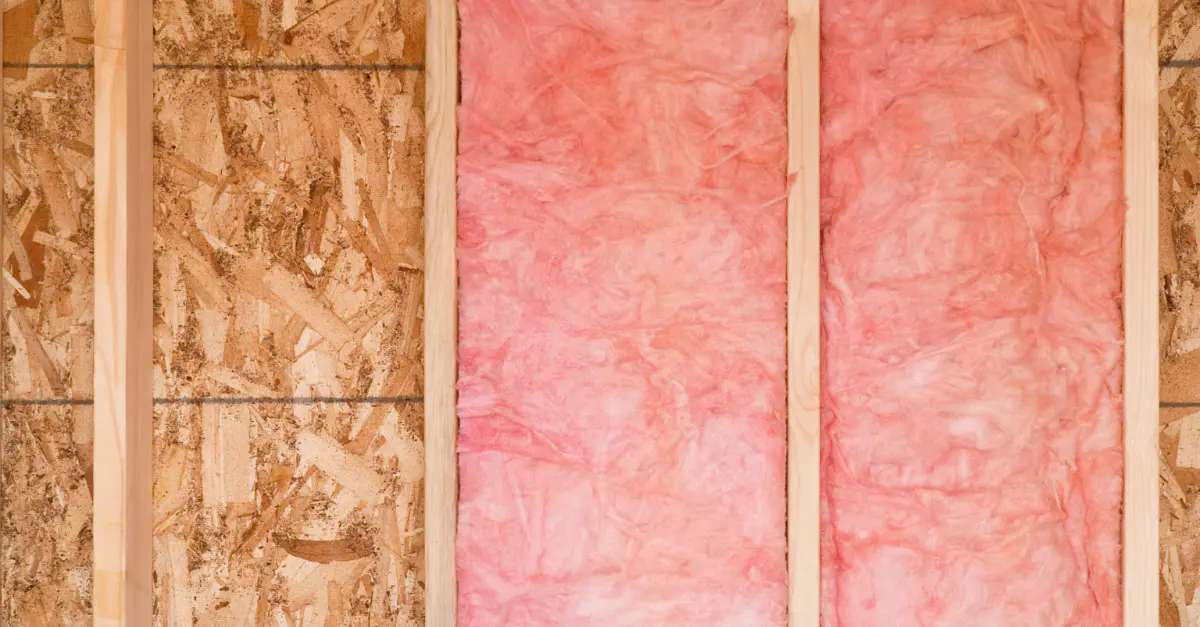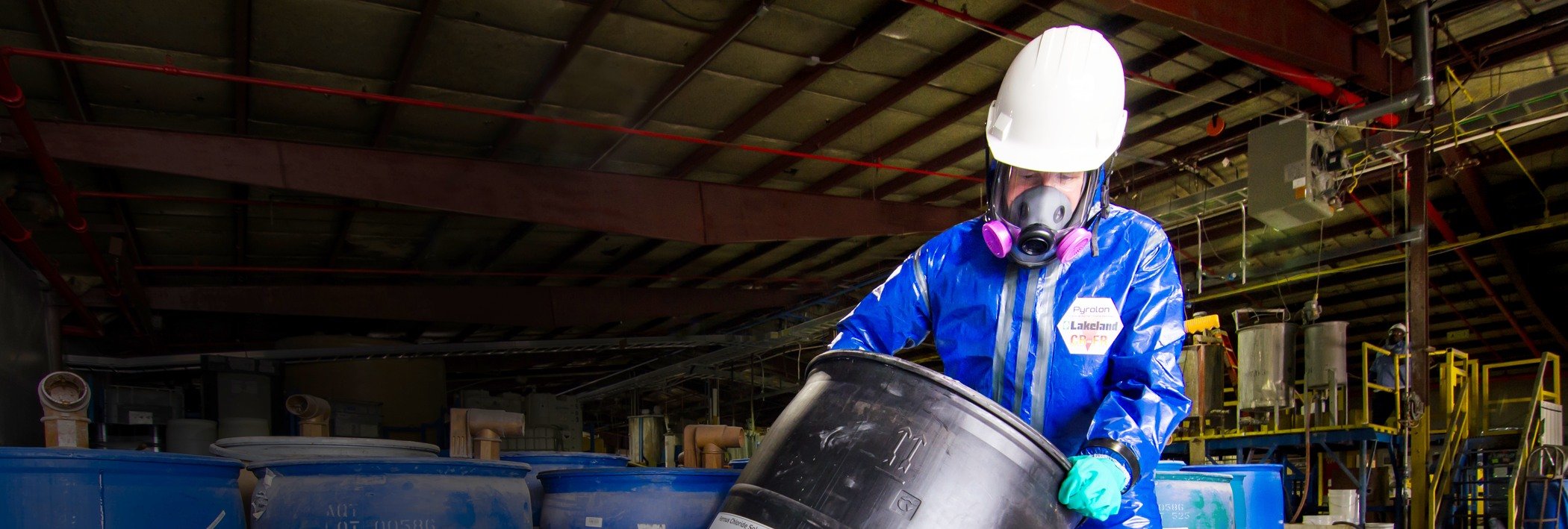Donning Do’s and Don’ts, Doffing Do’s and Don’ts
The processes of donning and doffing are commonly given too little attention despite the inescapable fact that they form a critical part of wearing a chemical suit, for two specific reasons:-
- A suit that is not donned and worn correctly may not protect properly. The best chemical suit in the world will be undermined if it is not donned and worn as it should be.
- The surface of a used suit may be contaminated with a hazardous chemical making doffing a potentially dangerous process in its own right.
So effective donning and doffing procedures are vital in ensuring protection from chemicals. There are numerous videos and content detailing specific donning and doffing procedures available on the internet, often focussing on specific products. To some extent any chosen procedure will relate to specific design elements of the chemical suit you use.
Yet there are a number of simple, overall principles that should be followed when setting up your workplace donning and doffing process. This blog focusses on those important general do’s and don’ts.
The Importance of Donning and Doffing
Donning and doffing is not just a safety issue; ill-thought-out procedures can also affect costs.
For example, the simple choice of standing whilst pushing the feet into a disposable coverall means an increased risk of losing one’s balance and a greater likelihood of damaging the suit and making it unusable before it has been used. Thus, effective donning and doffing can also have a positive effect on PPE spend by reducing wastage.
Meanwhile, the process of doffing is arguably the most hazardous part of wearing chemical protective suits. First, because of the obvious fact that used clothing is likely to be soiled on the outside surface so secondary contamination is quite likely when removing it. But also because for the psychology of the wearer; they are now safely removed from the critical area when the job is done so they are more likely to relax and take less care than they should.
This is where training is a vital part of any donning and doffing process. Not only to ensure that chemical PPE is worn properly, but also to ensure wearers maintain their guard and do not assume the job is done before removing the suit. Until the suit is removed safely, the danger is still very much present.
The Risk Assessment Starting Point
Because of its importance, it is good policy for a Safety Manager to conduct a “mini” risk assessment of the donning and doffing processes to identify key hazards, risks, and requirements. As with most chemical protection, this will start with developing an understanding of the chemical properties and the hazards it presents:-
- How hazardous is the chemical, and what are the consequences of contamination?
- Would a wearer be aware of contamination?
- Would contamination of the suit be obvious and clear?
- Can any contamination of the suit be sensibly removed before doffing? (bearing in mind the challenge of chemical that has permeated into the fabric at a molecular level)
The answers to these questions will guide the Safety Manager in identifying how critical is donning and doffing overall, along with identifying key risks that a procedure should address.
Following such a risk assessment, a procedure can be set up. Whilst some of the detail will relate to specific design elements of your selected chemical suit, the following are a list of general do’s and don’ts to consider.
Donning Do’s and Don’ts
The Donning and Doffing Environment and Preparation.
DO undertake donning and doffing in a clean, dry area ideally with plenty of space.
A constricted area is more likely to result in damage of suits and an increased likelihood of errors. And a user does not want to have a dirty suit before starting the actual work!
DO read chemical safety clothing user instructions carefully.
Certification to EN standards requires that all garments are supplied with a detailed user instruction sheet in the smallest unit of sale (so usually with every single garment) and in the language of the country where it is intended to be used (so often in multiple languages).
This makes these documents cumbersome and challenging. Yet whilst often containing very small text and not being easy to take in (without a magnifying glass!), it is vital to read and understand them. Not only will they provide detailed information on the properties of the suit, but they will also indicate both limitations of use and where any specific clauses in standards have been excluded from the certification assessment. [LINK to blog]
Such limitations and exclusions might be important. For example:-
- Some “Type 3 and 4” chemical suits, in reality, only achieve Type 3 IF the zipper cover is taped up with additional adhesive tape to properly seal the flap. If this is the case, it will be explained in the user instructions
- Some Secondary FR Workwear garments, specifically FR SMS coveralls certified to EN 14116, in reality, are only certified to part of this standard. Commonly, the zipper and seams have been excluded from any FR assessment, which means they are likely to be flammable and do not meet the FR requirements (otherwise why would they be excluded).
The Shortcomings of FR SMS Coveralls |
|
In simple terms, FR SMS garments, by their nature, are entirely unable to meet this requirement without insertion of an FR zipper and consequential dramatic increase in cost. So notified bodies have allowed them to be re-certified excluding the clauses that specifically make this new requirements (yes you read that right! These garments are certified to the new standard, except for the parts that were added in the new version). So actually they are only certified to the old standard, which according to Regulation 245 is not allowed. This is an indication of two important points:- 1. That CE certification is not always what it appears. The detail is important. Lakeland Pyrolon garments are a different matter, and fully meet the requirements of the 2015 EN 14116 standard. |
These examples show that reading User Instructions properly matters. Failing to recognize such limitations could mean your workers are not as well protected as you think.
DO conduct a thorough examination of the suit before donning
A visual check of the suit will ensure that it has not been damaged in transit or storage and avoid wasting time in donning a suit that should not be used.
Ideally, lay out the garment on a flat, smooth surface such as a table. Examine both front and back, checking for any tears or wear in the fabric, ensuring all seams appear intact and that any zipper or closure functions correctly.
DO consider using break facilities before donning the suit.
Donning and wearing a chemical safety suit can be a fairly involved process, and often, removal means it cannot be used again (often double-sided tape becomes less effective ,or suits may be damaged during removal). It might seem obvious, but whilst some disposable suits provide two-way zips for precisely this reason, a wearer does not want to go through the donning process and then find they need to use the toilet. A little thinking ahead can avoid a lot of wasted time and wasted PPE!
The Process of Donning Chemical Safety Clothing
DO work in pairs for both donning and doffing
Some parts of donning, and the majority of doffing, can only be done effectively by a partner, so always work in pairs.
For example, the final part of zipping up the front closure and especially fastening down any sealable zipper cover, often using double sided tape provided, can only be done effectively – that is, ensuring there are no folds or creases and that any locking mechanism in the zip is activated – by a second person.
Meanwhile, the whole of removing a chemical suit, given the danger of a contaminated suit, is best done by a partner.
It can also be good policy for staff, where possible, to always work in the same pairs. That way they get to understand the needs of the other and will work more effectively and efficiently.
The simplest solutions are often the best |
|
Many years ago I visited a factory in the East Midlands of the UK following a complaint that the disposable coveralls they were using commonly split before they had even put them on. The problem was related to only one specific worker. He was over 1.9M tall, well-built, sporting size 12 boots and as strong, as they say, as an ox! His process of donning these lightweight, disposable coveralls involved roughly pushing booted feet into the legs whilst standing, balancing on one foot and jamming these huge boots into the legs. Lightweight, disposable garments like these are not made from tough, resilient materials, and compared to their woven counterparts, will tear relatively easily. Not surprisingly, the suit was tearing during the process, often when the ankle elastic caught on the heel of the boot as was puled away from the fabric. The problem was easily solved by ensuring he removed his boots before donning, sat down to push feet into the coverall legs and then replaced the boots Sometimes the simplest solutions are the best. To avoid damaging suits, remove footwear and sit down to put feet into the legs of the coverall. |
DON’T try to do the initial stages of donning whilst standing and wearing footwear.
Standing and wearing boots whilst inserting feet into the clothing legs is a good way to lose your balance and fall, or to damage the suit before you have even put it on.
On the other hand…
…DO stand for the remainder of the process.
Whilst the first part of donning is best done sitting down, the last parts, final zipping up of the zipper, fastening zipper covers, positioning of hood and so on, can ONLY be effectively done (by your partner) whilst standing. These final parts are also far more effectively done by the partner whilst the wearer stands erect, motionless, and with arms outstretched.
DO consider a logical order of donning the full PPE ensemble.
For example, in normal circumstances, a breathing mask will be donned before the hood of the garment is pulled over the head, so that the mask straps are inside the hood and the face opening can be adjusted to fit the face-mask effectively and sealed with adhesive tape if required.
Or consider whether gloves should be donned before the coverall or after. This may depend on the specific design of the suit. For example, if the sleeves feature a double cuff, the suit will probably be donned first so the outer flap can be pulled over the glove after it is donned. On a single cuff suit, it might be either, depending on conclusions drawn from the risk assessment.
In the case of using a specialized glove connection, such as the Lakeland “Push-Lock” system, the gloves should be attached to the coverall before the coverall is donned.
The point is, consider the most appropriate order for donning all the PPE used with the objective of ensuring all protect as they should… and follow it.
DON’T underestimate the importance of joins between different items of PPE.
The most likely route for penetration of a hazardous liquid is through joins between different items of PPE (hood to mask, sleeve to gloves, and so on) rather than through the coverall itself. So the questions are whether these joins need additional measures to ensure a good seal, and if so, how can it be achieved?
Commonly additional chemical or gaffa tape is used to seal these joins. If so, ensure you have a proper process to apply and to ensure and check that it has been applied properly. However…
DON’T try to apply sealing tape, where used, to joins yourself.
You won’t do a good job of it. Application of such sealing tape can only be done effectively by a partner.
A further option for a sleeve-glove connection is a system such as the push-lock glove connectors.
DO have your partner conduct a final visual check of the full garment before entering a critical area.
With the wearer standing with arms outstretched, the partner should conduct a careful, visual check around the whole ensemble, making final adjustments, and paying particular attention to any damage or wear and that seams and joins are intact. This is the only way – that is, when conducted by a partner – that an effective visual check can be made.
DO produce a final written checklist that must be completed, signed, dated, and recorded every time a chemical suit is donned.
Apart from helping to ensure all the important requirements are met and that nothing important is omitted, in the event of any accidents, having such records may be important.
Doffing Do’s and Don’ts
The process of removing a chemical safety suit is perhaps the most dangerous part of wearing one, partly because the outside of the suit may be contaminated and partly because having completed the task and emerged from the critical area, wearers might be tempted to take the greatest risks. Chemical suits are not comfortable to wear, and the instinct once the task is complete is to get the damned thing off as quickly as possible!!!
However, ensuring you adhere to a number of Do’s and Don’ts during doffing will help avoid accidents.
DO assess whether the garment is contaminated and whether it should undergo any cleaning process, such as through a decontamination shower, before doffing.
It is always wise to remove any heavy soiling before doffing. But do consider whether a chemical might have permeated into the fabric. It is problematic to remove this through normal decontamination procedures.
DON’T forget to consider the properties of the chemical… if the suit IS contaminated… will it be apparent?
Contamination of chemicals may not be easily visible on a garment, and wearing a garment unavoidably restricts the wearer’s senses so they may not be aware that contamination has occurred.
Chemicals with strong colors might mean easy recognition of contamination, but the assessment of the chemical should include whether it will be clear or not. If not, additional measures and care may be required.
DON’T try to remove a contaminated garment yourself!
As with donning and even more so with doffing, removal of a contaminated chemical suit can only be done safely by your work partner. If you try to do it yourself you will greatly increase the risk of cross-contamination.
DON’T forget the partner removing the coverall will also need suitable PPE.
Especially with a contaminated suit and if the chemical is particularly hazardous, the partner will also need suitable protection. As a minimum, this will include gloves but depending on the chemical, level of contamination, and circumstances, full coverall protection might be appropriate. The risk analysis should clarify this.
DON’T remove gloves BEFORE removing the coverall (unless there are specific reasons for doing so)
The instinct is to pull off the gloves first. But if hands are uncovered during the rest of the doffing process there is a far greater chance that they will be contaminated by any residue on the garment. In an effective doffing process, the gloves will be removed as one movement with the coverall, turning inside out in the process.
DO identify an effective and logical order and method for doffing of the whole PPE ensemble.
In most cases, this process will involve:
- Removal of any tape sealing up PPE joins.
- Partial unzipping of the coverall and pulling back of the hood, turning it inside out in the process.
- Full unzipping of the coverall.
- As the wearer stands with arms outstretched to the side, the coverall can be peeled back and down from the rear, pulling the arms, with gloves out of the sleeves, then pulling the garment down the legs, turning the whole thing inside out in the process.
- Using this method, any contamination on the outside surface ends up on the inside of the final bundle.
DO sit down for the final part of removal.
Whilst the wearer sits, the partner can remove boots and pull the garment bundle from the legs.
DO have a suitable receptacle – a polythene bag for example – immediately available for the removed bundle to be placed in for disposal.
You do not want to be leaving a contaminated garment on the floor whilst you search for something to put it in!
DO provide re-hydration facilities in the doffing area if safe and feasible.
Wearing a chemical suit is hot and thirsty work, and once doffing is complete a drink will be sorely needed!
General Donning and Doffing policies
Finally there are some more general policies, which if followed, will help ensure your donning and doffing process are comprehensive and remain effective:-
DO have your established donning and doffing procedure written up and available visually in the donning and doffing areas.
A written process will help ensure all the required points identified in the risk assessment are addressed, will provide a basis for training programs and a starting point for a donning and doffing review.
DON’T assume users will understand how to don and doff properly; establish training programs to support your finalized process.
Reinforce the training periodically and DON’T forget to ensure any new employees undergo the training
DO review the donning and doffing process periodically to ensure it is effective and properly followed by staff
This is especially important when any PPE or other factors change.
And finally…
DON’T TAKE RISKS!!!
Perhaps the most dangerous words in the safety industry are “It’ll be OK”. A chemical suit not worn properly will not protect properly and when you are dealing with “killer chemicals” [LINK].
The importance of a good donning and doffing procedure, along with establishing and maintaining training whilst establishing a safety culture to reinforce it, cannot be under-estimated.
Issues Specific to Lakeland ChemMax® Chemical Safety Clothing
Whilst the above list of Do’s and Don’ts apply generally to all chemical suits, Lakeland garments feature some specific design elements that are worth mentioning:-
Super-B Design.
Lakeland ChemMax range of chemical safety clothing use a design featuring a unique combination of elements resulting in a garment that is more ergonomic, better fitting, and allows greater freedom of movement as explained in the video below.
In particular, the three-piece hood with shaped center panel means a more rounded hood and a better fit to the rim of a respirator mask, making sealing with adhesive tape less necessary – and easier if your risk assessment demands it.
Double Zip & Storm Flap
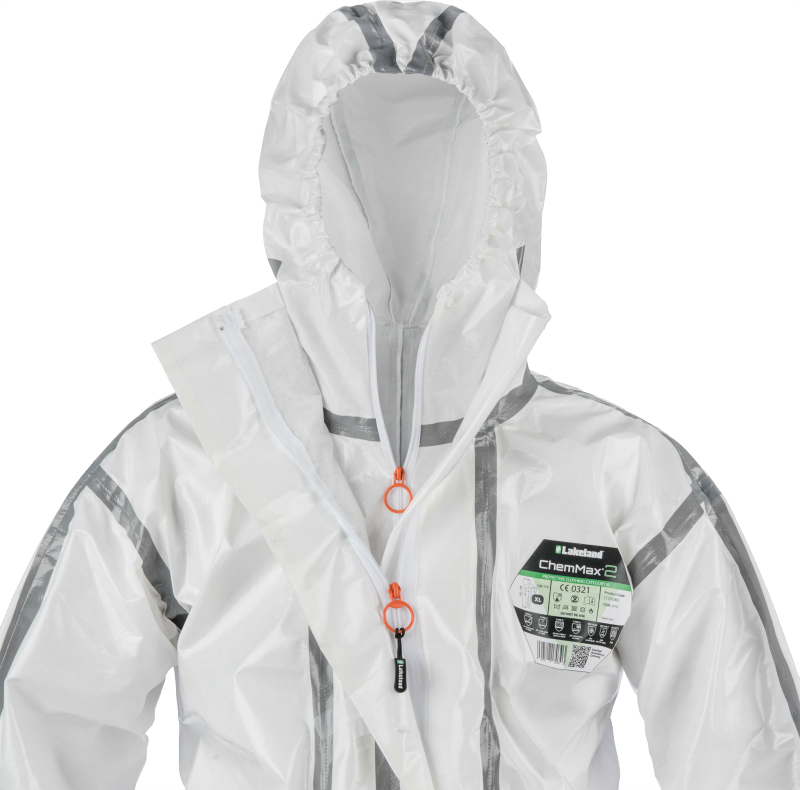
Even more so than garments with single zips and flaps, Lakeland double zip arrangement is fare more easily closed properly by a partner.
External CE label
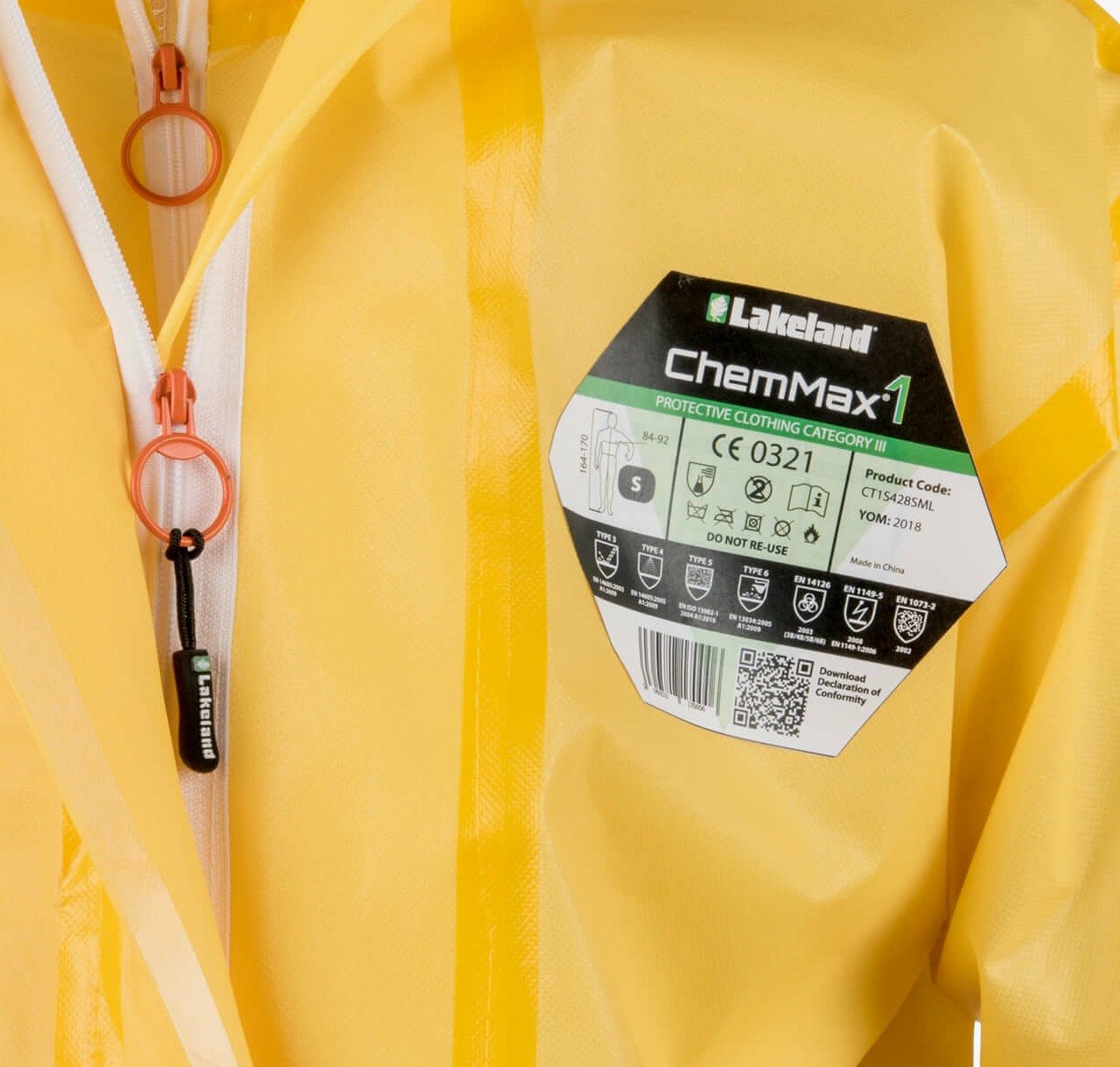
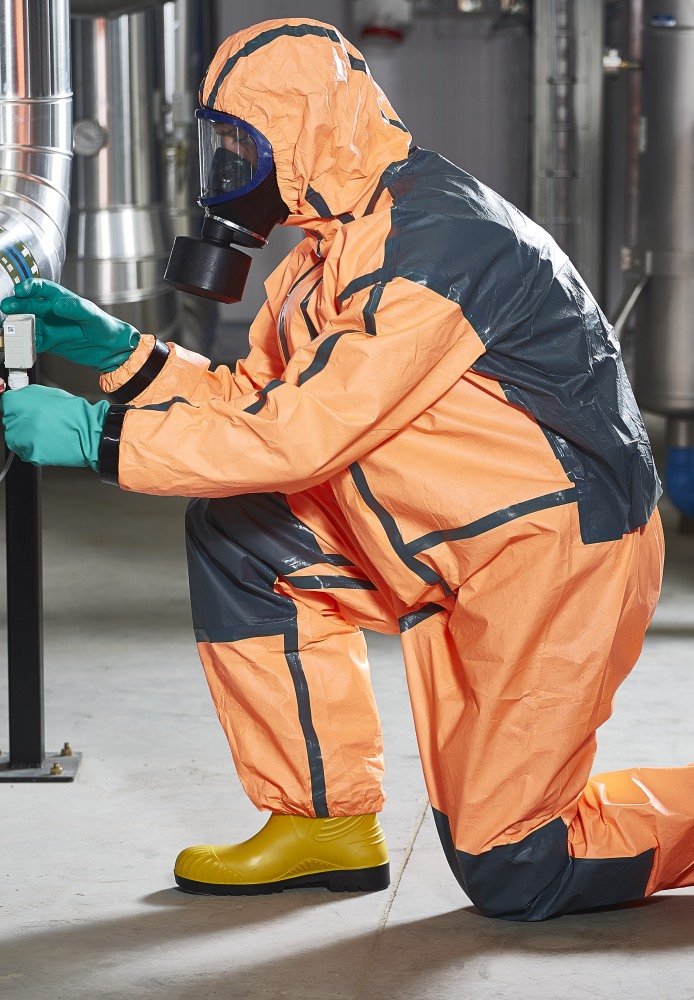
CONCLUSIONS… As Always, the Devil is in The Detail…
The importance of a good donning and doffing process should never be underestimated – especially in the case of applications involving highly hazardous chemicals.
You may well spend money to buy the best PPE in the world to ensure your workers have the best protection, yet if you fail to ensure they don and wear it properly, the spend could be pointless.
Meanwhile doffing, because it can involve contaminated PPE, can be as hazardous – if not more so – than the very task for which it is worn, so it needs particular attention
Selecting and procuring effective and suitable PPE is the first stage of protecting your workers. Ensuring that PPE is always worn and used properly is even more challenging and is ongoing; a continuing process of risk assessment, establishing effective processes, training and re-training and reviewing.
It can never be perfect and can always be improved. Ensuring your donning and doffing processes are comprehensive and consistently followed is a key part of that process.


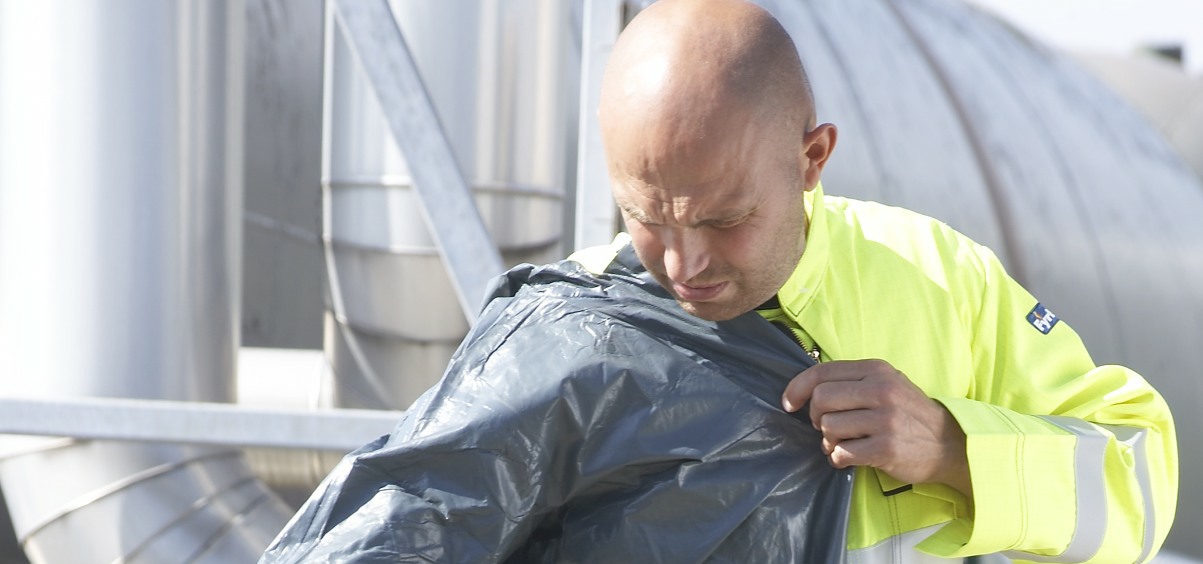




 The new version of the 2015 EN standard for disposable FR coveralls introduced new requirements – specifically (and for obvious reasons) that components such as zippers and seams meet the same FR requirements as the fabric.
The new version of the 2015 EN standard for disposable FR coveralls introduced new requirements – specifically (and for obvious reasons) that components such as zippers and seams meet the same FR requirements as the fabric.